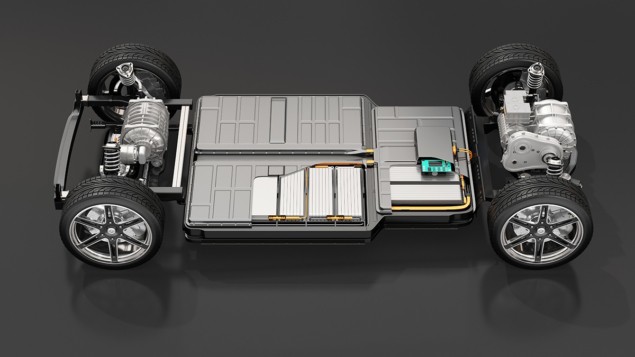Quantum sensor could reduce electric-vehicle battery weight by 10%
18 Sep 2022
Slimmed down The new quantum sensor could reduce battery weights by 10%. (Courtesy: Shutterstock/Chesky)
A new quantum sensor can measure the energy stored in electric-vehicle batteries much more accurately than existing devices – according to its inventors Mutsuko Hatano at the Tokyo Institute of Technology and her colleagues in Japan. Their sensor uses nitrogen–vacancy (NV) centres in diamond and could lead to substantial improvements to the range and energy efficiency of electric vehicles.
Electric vehicles (EVs) are widely viewed as a crucial element of the global effort to eliminate greenhouse-gas emissions. One limit on their efficiency is an EV’s ability to estimate how much energy remains its batteries.
Today, the remaining energy is estimated by measuring the electrical current flowing from the batteries as the EV is being driven. Although these currents can reach up to hundreds of amperes, their average value is typically just around 10 A. As a result, the current sensors must operate over a large dynamic range, which makes them highly susceptible to noise from the surrounding environment.
Safety margin
This noise means that a battery’s remaining energy can only be estimated to within an accuracy of around 10%. Therefore to be safe, EV batteries must be recharged once they drop to 10% of their energy capacity. This puts a significant limit on the driving range of an EV and means that heavier batteries are required to achieve a target range.
To improve on this accuracy, Hatano’s team measured the current using a pair of diamond quantum sensors based on NV centres. An NV centre is an impurity in which two carbon atoms in a diamond lattice are replaced by a single nitrogen atom and an adjacent empty space.
An NV centre behaves as a tiny spin magnetic moment that is very sensitive to external magnetic fields. These fields can be measured very precisely by probing NV centres using light and microwaves.
Differential measurement
In their study, the researchers placed a pair of the diamond sensors on either side of an EV busbar, which is a thick strip of metal that connects an EV’s battery to its motors and other electrical components. As a current passes through the busbar, it creates a magnetic field that is measured by both diamond sensors. Because the sensors are located on either side of the busbar, one sensor measures a positive value for the magnetic field and the other measures a negative value. Crucially, they both measure the same levels of noise – so subtracting one measurement from the other eliminates the noise.READ MORE

Using this differential technique, the team measured currents in the busbar as high as 130 A, and as low as 10 mA – even in noisy environments. The team then cranked up the current to ±1000 A and operated the sensor in the –45°C–85°C temperature range and observed good measurement performance.
The team says that the sensors could reduce the weight of EV batteries by 10%, which would lower the energy required to both run and produce EVs. They estimate that the commercial rollout of the sensors could ultimately reduce the carbon dioxide emitted by the transport industry by some 0.2% by 2030 – potentially bringing the goal of net-zero carbon emissions one step closer.
The research is described in Scientific Reports.
Sam Jarman is a science writer based in the UK
FROM PHYSICSWORLD.COM 20/10/2022

Δεν υπάρχουν σχόλια:
Δημοσίευση σχολίου